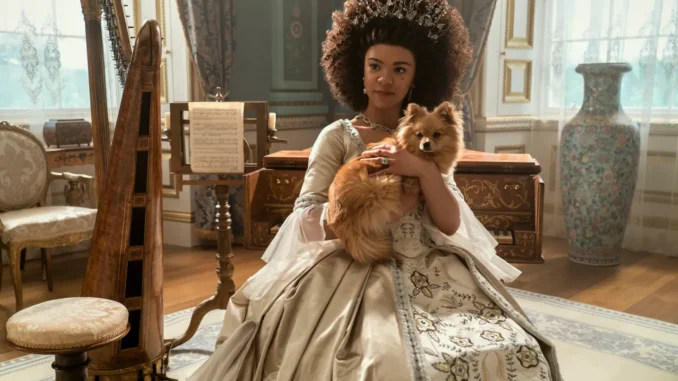
The first episode of the Bridgerton prequel series, Queen Charlotte: A Bridgerton Story, opens with a disclaimer from none other than the notorious Lady Whistledown. In her note, she states that the royal’s story “is not a history lesson,” but instead, “fiction inspired by fact,” where “all liberties taken by the author are quite intentional.” While the show, which released this week on Netflix, definitely takes many liberties while spinning the tale of the epic romance between Queen Charlotte and her beloved husband, King George III of England, the characters were actually inspired by the real-life British monarchs of the same names.
In the series, which jumps between the early years of Charlotte and George’s marriage during the early Georgian period (around the 1760s) and the Regency era (the early 1800s) of Bridgerton, viewers get a glimpse of two different Charlottes: the dynamic and grandiose Queen Charlotte (Golda Rosheuvel) they know from previous installments of Bridgerton seasons, and the fiercely independent 17-year-old German Princess Charlotte (India Amarteifio), who’s set to wed George III, the King of England (Corey Mylchreest). Both Charlottes face challenges—the older Charlotte, despite having given birth to 13 living heirs, has no legitimate grandchildren to ensure that their bloodline endures, while the younger Charlotte must navigate a new country, the mysteries of marriage with a contrary husband, and perhaps most pressing, the tensions that arise with her interracial marriage, which not only makes her the first Black royal, but also leads to the integration of the “ton,” or British high society.
While Bridgerton, with its colorblind casting, rarely centered racial issues, Queen Charlotte, a true Shonda Rhimes joint, doesn’t shy away from making race an integral part of multiple story lines, addressing everything from colorism to segregation and integration. But while these important themes help to make the show a captivating and thought-provoking watch, there’s definitely a liberal blurring of the lines between history and fantasy in the series.
With that in mind, here’s a breakdown of what’s fact and what’s fiction in Queen Charlotte.

Was Queen Charlotte really Black?
One of the major storylines of Queen Charlotte is how the protagonist navigates the trials and triumphs of being the first Black queen of England. However, in real life, it’s debatable whether or not the monarch was actually Black. The character of Charlotte is based on Princess Sophie Charlotte of Mecklenburg-Strelitz, a figure whose racial identity has been in question for decades. Initial speculation about Charlotte being Black or of mixed-race descent began in the 1940s, after the Jamaican-American journalist and historian J.A. Rogers theorized in his book Sex and Race: Volume I that because of the facial features she was depicted with in portraits, which he identified as “broad nostrils and heavy lips,” she may have been part Black.
While Rogers posited this to confront the problematic belief in a “pure white race,” the theory was revisited by historian historian Mario De Valdes y Cocom in a 1997 piece for PBS Frontline (which was later edited due to outdated and offensive language), where he makes the case that Charlotte was Black because she was a direct descendant of Margarita de Castro y Sousa, a Black branch of the Portuguese royal house through Margarita de Castro e Souza, whom The Guardian reports was “a 15th-century Portuguese noblewoman nine generations removed, whose ancestry she traces from the 13th-century ruler Alfonso III and his lover Madragana, whom Valdes takes to have been a Moor and thus a black African.”
However, other historians are doubtful that this proves that Charlotte was Black or of mixed-race descent. In an interview with The Philadelphia Inquirer, academic Ania Loomba said that the assumption that Charlotte was Black because her ancestry included descriptions of “moors” relies on an inaccurate understanding of history.
“The word ‘blackamoor’ in Shakespeare’s time meant Muslim,” Loomba said. “It didn’t mean Black necessarily. Moors could be white from North Africa.”
Did “The Great Experiment” really exist?
In the series, Charlotte’s visibility as the first Black queen of England leads to the crown giving titles to other people of color and inviting them to join the then-segregated court and the “ton,” including a young Lady Agatha Danbury (Arsema Thomas,) who becomes one of the queen’s ladies-in-waiting. The reasoning behind this racial integration, which the powers at court dub “the Great Experiment,” is that it showed support for Charlotte and reinforced the power of the crown in setting the tone and practices for its court and subjects.
